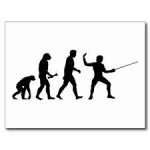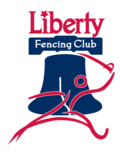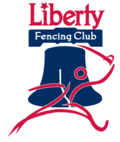There are many benefits to participating in fencing. Fencing develops discipline, balance, coordination, and sportsmanship. Fencing helps children develop quicker reflexes and the ability to make lightning fast analyses of tactical situations.
Through fencing, young people learn good sportsmanship and self-discipline. They learn to compete independently as well as for a team. They learn to enjoy winning and profit from defeats, while becoming physically fit and healthy. Most importantly, they learn to make complex decisions, analyze problems, and think fast. These ideals help children reach their potential in many areas other than fencing.
The benefits of fencing extend to the college recruitment process. College coaches are now recruiting fencers with years of competitive experience in the local, national, and international realms. Many of the colleges that recruit experienced fencers are among the nation’s elite: Harvard University, Princeton University, and University of Pennsylvania are some of the many universities that look for top scholar-athletes to join their fencing programs.
Foil
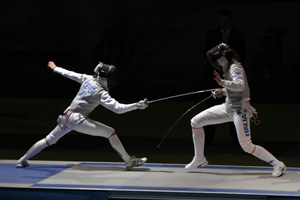 The foil is a descendant of the light court sword formally used by nobility to train for duels. The foil has a flexible, rectangular blade, approximately 35 inches in length, and weighs less than one pound. Points are scored with the tip of the blade and must land within the valid target area, which is the torso from the shoulders to the groin in the front and to the waist in the back. It does not include the arms, neck, head and legs. This concept of on-target and off-target evolved from the theory of 18th-century fencing masters, who instructed their pupils to only attack the vital areas of the body. Of course, the head is also a vital area of the body, but attacks to the face were considered unsportsmanlike and therefore discouraged.
The foil is a descendant of the light court sword formally used by nobility to train for duels. The foil has a flexible, rectangular blade, approximately 35 inches in length, and weighs less than one pound. Points are scored with the tip of the blade and must land within the valid target area, which is the torso from the shoulders to the groin in the front and to the waist in the back. It does not include the arms, neck, head and legs. This concept of on-target and off-target evolved from the theory of 18th-century fencing masters, who instructed their pupils to only attack the vital areas of the body. Of course, the head is also a vital area of the body, but attacks to the face were considered unsportsmanlike and therefore discouraged.
The foil fencer’s uniform includes a metallic vest (called a lamé), which covers the valid target area so that a valid touch will register on the scoring machine. The flexible nature of the foil blade permits the modern elite foil fencer to attack an opponent from seemingly impossible angles.
Epee
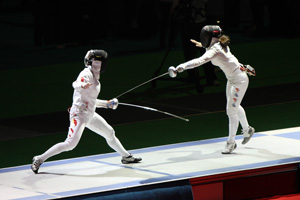 The epee (pronounced “EPP-pay,” meaning sword in French), is the descendant of the dueling sword, is similar in length to the foil, but is heavier, weighing approximately 27 ounces, with a larger guard (to protect the hand from a valid hit), and has a much stiffer blade. Touches are scored only with the point of the blade, and the entire body, head-to-toe, is the valid target area, imitating an actual duel.
The epee (pronounced “EPP-pay,” meaning sword in French), is the descendant of the dueling sword, is similar in length to the foil, but is heavier, weighing approximately 27 ounces, with a larger guard (to protect the hand from a valid hit), and has a much stiffer blade. Touches are scored only with the point of the blade, and the entire body, head-to-toe, is the valid target area, imitating an actual duel.
A full-body target naturally makes epee a competition of careful strategy and patience – wild, rash attacks are quickly punished with solid counter-attacks. Therefore, rather than attacking outright, epeeists often spend several minutes probing their opponent’s defenses and maneuvering for distance before risking an attack. Others choose to stay on the defensive throughout the entire bout.
Sabre
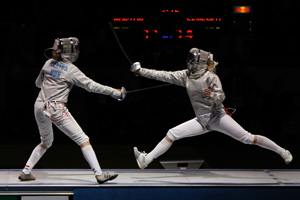 The saber is the modern version of the slashing cavalry sword, and is similar in length and weight to the foil. The major difference is the use of the blade. The saber is a cutting weapon as well as a thrusting weapon. Therefore, saberists can score with the edge of the blade as well as the point. The target area is from the bend of the hips (both front and back), to the top of the head. This simulates the cavalry rider on a horse. The uniform includes a metallic jacket (lamé), which fully covers the target area to register a valid touch on the scoring machine. Because the head is valid target area, the fencer’s mask is also electrically wired.
The saber is the modern version of the slashing cavalry sword, and is similar in length and weight to the foil. The major difference is the use of the blade. The saber is a cutting weapon as well as a thrusting weapon. Therefore, saberists can score with the edge of the blade as well as the point. The target area is from the bend of the hips (both front and back), to the top of the head. This simulates the cavalry rider on a horse. The uniform includes a metallic jacket (lamé), which fully covers the target area to register a valid touch on the scoring machine. Because the head is valid target area, the fencer’s mask is also electrically wired.
In saber, the rules of right-of-way strongly favor the fencer who attacks first, and a mere graze by the blade against the lamé registers a touch with the scoring machine. These circumstances naturally make saber a fast, aggressive game, with fencers rushing their opponent from the moment the referee gives the instruction to fence.
